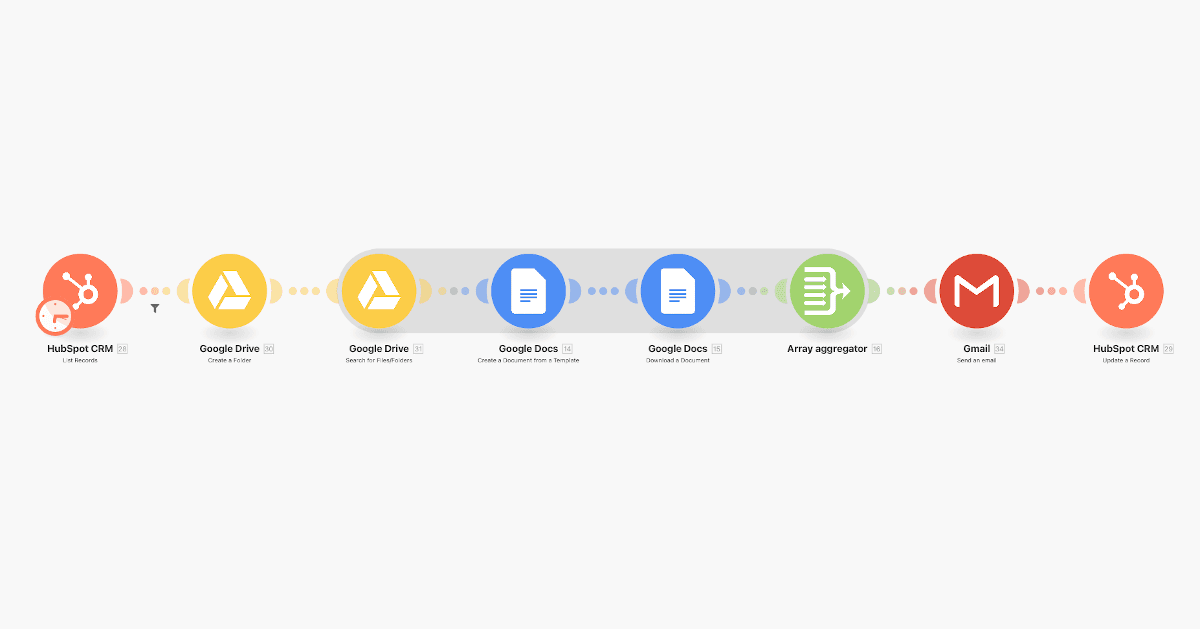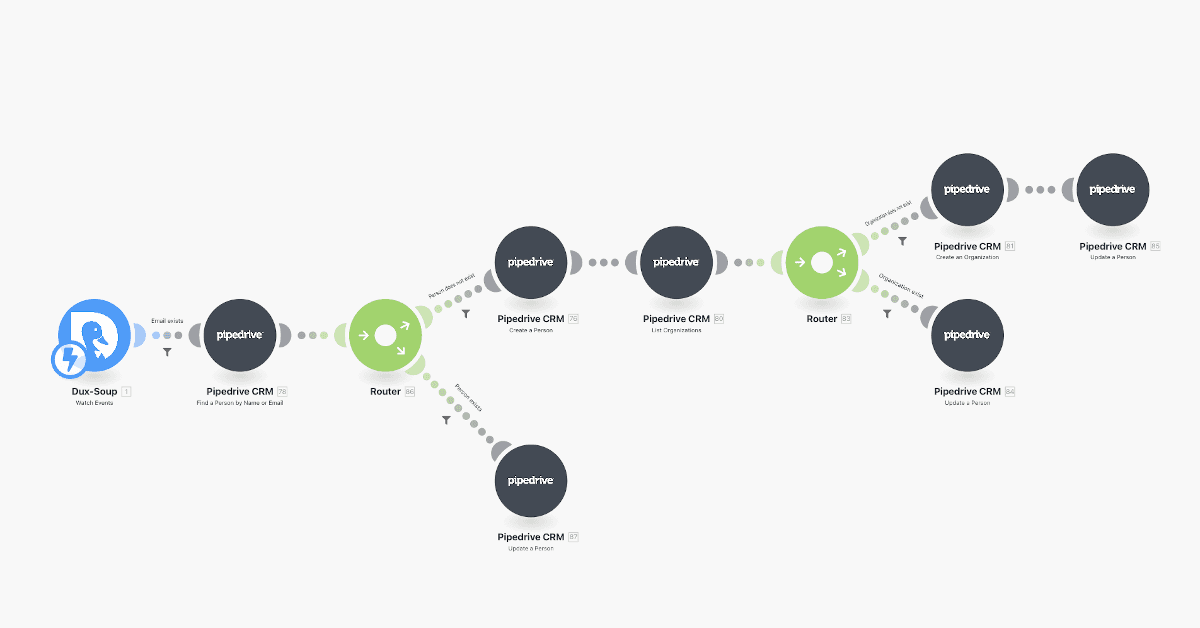Feb 3, 2021 | 11 minutes
10 Sales Processes You Can Automate Right Away with Make
Spending too much time on repetitive sales tasks? Learn how to automate your processes and focus on selling instead.

If you ever worked in sales, you know that a significant part of the day is spent on a series of repetitive tasks and processes related to:
Email: Sending reminders, replying to communications
Data Entry: Filling out information in the company CRM
Prospection: Finding leads through different channels
Research: Nurturing leads with valuable information before selling
Documents: Drafting proposals, contracts and other presentations
Studies have shown that sales professionals spend most of their time on these tasks, instead of focusing on what actually matters the most: selling.
As Lynne Zaledonis (SVP Product Marketing at Salesforce) said:
“A sales rep can only be as productive as the time spent selling.”
Image Source: Intercom
The question is: How can sales professionals focus more on selling, and less on repetitive tasks?
The answer to this problem is called sales automation, and it's the topic we will be covering today in this article. We’ve used some of the most popular sales tools out there to help you automate your processes, including:
LinkedIn
Pipedrive
Hubspot
Calendly
SalesFlare
But first things first: let’s start with the basics.
What is sales automation?
Sales automation is the mechanization of the boring, menial tasks. With the help of software to automate sales processes, sales reps can focus on other important tasks and goals related to selling.
Because sales processes are usually linear, automation can be beneficial to:
Reduce customer response times (with chatbots for example)
Improve productivity using reminders
Promote accuracy with automatic sync between tools
Increase sales velocity
Before we dive in further, let’s stop for a moment on the concept of sales velocity, which is key to understanding the importance of sales automation.
What is sales velocity?
Sales velocity is a formula to forecast how long it takes a business to generate revenue. It puts into perspective how fast customers are moving through your sales pipeline (from lead to customers).
Image Source: Intercom
As you can see, the sales velocity formula is composed of four elements:
Number of opportunities
Average deal value
Win rate, also called conversion rate
Length of sales cycle, measured in days
To calculate sales velocity, you have to multiply the number of opportunities by the average deal value and win rate, and then divide the result by the length of your sales cycle. The result of this operation will be your business' sales velocity.
Let’s put the formula in context with an example. You’re working on five opportunities where the average deal value is $10,000. Your win rate is 30%, and the average time it takes to close a deal is 60 days. Now, let's use the formula to calculate sales velocity.
(5 * 10,000 * 0.3) / 60 = 250
In this example, your sales velocity is $250 a day.
As a salesperson, this is useful to get a realistic look at your quota, and see whether there is a need for increasing your sales velocity or not. If you’re underperforming, you can adjust each of the elements that compose the equation by:
Closing more deals
Increasing deal size, by focusing on bigger contracts
Generating more opportunities, by qualifying prospects more effectively
Reducing the sales cycle length, by spending more time selling
Here exactly is where sales automation can help you. Let’s see how.
How to automate repetitive sales tasks?
Sales process automation is not a new concept. Companies like Oracle have been helping companies streamline sales processes for decades. However, their solutions are more oriented toward large enterprises, and not always accessible to the millions of businesses that, while very successful, do not operate at that scale.
Fortunately, companies today have options that are powerful, affordable, and not nearly as technically challenging as the ones offered by legacy industry players.
The main options to automate sales tasks these days include:
Taking advantage of native automation features (Salesforce)
Adopting a suite of integrated products (Zoho)
Using a dedicated automation platform (Make)
Each of these is valid depending on your business needs and your automation strategy. We of course believe that using a dedicated platform is the best option, as these help you standardize processes and reduce the time and cost of developing, launching, and replicating automated solutions across entire teams.
10 sales tasks you can automate with Make
In this list, we will go over 10 repetitive tasks every salespeople should consider automating. Each will feature an Make template that can be used right away. Bear in mind, you will need an Make account to use the templates. If you don't have one yet, please create one for free (no card required).
1. Send data to your CRM automatically to get rid of copying and pasting
Studies have shown that the average sales rep spends almost four hours a week updating their CRM (source).
Now, what can you do to stop wasting your time on this, and gain back those four hours for yourself?
Image Source: Salesforce
The first thing to know is that most CRM data entry tasks are basically copying and pasting.
For example, when adding a new contact, it is good practice to copy important information from social media to give some context, such as:
Previous companies
City and state
Alma mater
Connections in common
So, how can automation help the sales process here? Simple: by automatically pulling information from social media.
Doing this will keep your leads nurtured, and save you valuable time that you can use to further improve your sales process.
Use this template to automatically pull LinkedIn contact info to a new HubSpot CRM company, so you don’t have to copy and paste information.
2. Craft contracts and proposals automatically to focus on relationships, not documents
Sales teams handle, create and send out a lot of different documents, including:
Presentations
Product leaflets
Proposals
Invoices
Contracts
These often have to be customized for each customer. Whether it's applying a logo to a contract or adding a custom price quote, these administrative tasks take time and energy.
The good news is that you can automate many of these tasks. From invoice processing to contract drafting, Make can pull the information directly from your CRM and push it to your document creation software.
Use this template to create documents (such as contracts) for a new deal in HubSpot CRM when it meets a specified criteria.
3. Qualify leads automatically to always land in the inbox
Qualifying leads is a very important part of sales: time is precious and you want to make sure you’re focusing on the most valuable prospects.
But before even thinking about budget or timeline, you have to make sure your contact info is correct. Imagine crafting the perfect email only to end up with a dreaded “we couldn't deliver your message” automatic reply.
Tools like NeverBounce allow you to verify email deliverability and ensure you’re not wasting your time. Coupled with your CRM, it’s a powerful, automated way to get rid of a nagging problem.
Use this template to validate contacts in HubSpot CRM using NeverBounce, to make sure their contact information is accurate and valid.
4. Automatically scour the internet to generate a constant influx of leads
You cannot talk about sales without addressing lead generation. Reports show that salespeople spend, on average, 17% of their day prospecting and researching leads. Lead generation is crucial, but it doesn't come without problems, as it can get::
Repetitive: No matter how lean the process is, there will always be dead ends
Inaccurate: It can sometimes feel like shooting in the dark
Messy: Are you sure you haven’t reached out to this person already?
In this regard, using social media the right way is instrumental to get high-quality leads. For example, on LinkedIn, professionals voluntarily list their company, activity and interests. It makes it easier to reach out, but also to get relevant information.
Dux-Soup is a LinkedIn lead generation tool that allows users to automate their prospecting efforts on LinkedIn using filters, inmails and connection features.
Image Source: Dux-Soup
What's best, Dux-Soup is compatible with Make. It can be used to create a number of automated scenarios and processes, making prospecting and lead generation seamless. Coupled with your CRM, it will help you get a steady flow of leads coming your way.
Use this template to connect Dux-Soup to Pipedrive CRM, automatically creating contacts from scanned Linkedin leads.
5. Follow-up with incoming leads while the iron is still hot
Timing is of the essence in sales. With inbound leads, interacting in a timely fashion dramatically increases the quality of the conversation. As a matter of fact, waiting just 10 minutes to respond drops the likelihood of qualifying the lead 4X (Source).
Chatbots are a great way to capitalize on this. They can help you:
Engage with customers automatically
Send qualifying questions to visitors on your website
Handle simple questions and complaints
Create rapport through a smooth user experience
The key here is to cover all your bases, and to achieve this, nothing beats cross-platform automation. By reaching out to customers across different channels, you can maximise the odds of getting a response. And the cherry on top is that you don't have to manually do all the heavy lifting, as large parts of the process can be automated.
Use this template to send Mailgun email to new Facebook Lead Ads leads.
6. Sync your meetings across tools to stay on top of your schedule
If calls represent a vital part of your selling process, you understand how dreadful it is to forget about a scheduled call.
It happens more than you think and for good reason. Consider the amount and variety of meetings salespeople have to attend:
Discovery calls
Sales calls
Presentations
Follow-ups
Team meetings
This constant influx of calls and meetings can quickly become draining, and tight schedules are often anxiety-inducing.
Automation is a great way to make sure you don’t miss out on your engagements. Syncing events between tools or setting up reminders is a great way to stay organized without the hassle of figuring it out.
Use this template to add new Calendly events to your Google Calendar.
7. Automate your sales pipeline to react as soon as any changes take place
Consider the sales funnel:
Image Source: Zendesk
As you get closer to the purchase, interactions become more valuable. Reacting timely is paramount to ensure all the precious time you’ve dedicated to that deal doesn’t go to waste.
While it might be easy to keep track of your sales pipeline early on, it can become a challenge as it grows. Automation can help by setting up reminders and alerts, letting you know when deals move through the funnel and when it’s time to reach out.
Use this template to receive Slack messages when Salesflare opportunities reach a certain stage.
8. Send leads to the appropriate rep based on specific criteria
Lead routing, also referred to as lead distribution, is the action of assigning leads to different team members, based on a set of predetermined criteria.
Image Source: LeadSquared
The criteria can go from basic requirements (language ability) to using more granular traits (experienced with similar company profiles). To implement lead routing, sales teams can choose from different options:
Implement a lead routing feature within their CRM
Use a dedicated lead routing solution such as LeadSquared
Setup a custom lead routing automation using a sales process automation tool
Make falls under the third category, offering the most flexibility and customization for your buck. By allowing you to link different bases on Airtable, it allows you to create advanced automations internally, including setting up an automated lead routing process.
Check out this step-by-step guide to see how you can link Airtable bases using Make.
9. Get notified when a payment is due to ease up the collection process
Being in sales without addressing accounts receivable is like being in a romantic relationship with the expectation of not having a fight every once in a while.
Sure, going after clients with overdue payments is not fun. Depending on your organization, it might fall under your responsibility, as sales should already have some sort of relationship with the customer in the first place.
The secret here is to have a sound process in place to deal with these types of situations. For example, invoicing tools such as Quickbooks or Invoice Ninja feature reminders and alerts that will send you and email once an invoice is due.
Alternatively, you can use Make to integrate your invoicing software with your favourite communication tool, and get notified when an invoice is due.
Use this template to be reminded on Slack when an invoice is created on Invoice Ninja.
10. Go the extra mile to delight prospects and customers
While we generally advise not to use automation for highly personalized tasks, there are a few exceptions.
Services like Thankster allow you to create handwritten cards online and send it by snail mail. Coupled with Make, it’s a powerful way to create a personalized, automated outreach. Here are some ideas you can implement:
A welcome letter to new customers
An appreciation letter for customers whose subscription is ending soon
A “Happy New Year” card to customer you’ve closed over the past year
When used alongside your CRM, it can be a fun campaign to think about.
Use this template to Create a new Thankster card from a new Contact in HubSpot CRM.
Important information to consider before automating your sales processes
Now that we’ve gone over a number of automations for your sales tasks, a word of advice.
We love automation. But we’re the first to say that it is not a magic solution to every business problem. While automating repetitive sales tasks makes total sense, other sales activities require a human’s undivided attention.
Here are 4 simple rules to follow when implementing your automated sales processes:
Don’t overdo it: Keep it personal and limit automation to menial tasks
Watch the deal value: The more expensive, the less you should automate
Test before using: No one likes to receive a “hi {{first_name}}!” email
Value the human: Demos, money conversations and resolving issues require human interaction and are a great way to build rapport
A good rule of thumb is to start with something light; if it works, you can expand your automation efforts to harder, more complex tasks.
Conclusion
Our advice is simple: as an enabler, you have to make the most out of automation. Getting rid of distractions is key for sales professionals to do their job.
Sales automation solutions are plentiful thanks to the current state of sales, and also due the variety of tools used:
CRM
Email client
Prospecting tools
Social media
Once you’ve freed enough time to focus on selling, you can start tackling even more areas of your sales journey.
Until then, happy automating!
Ready to make the automation revolution happen?




















